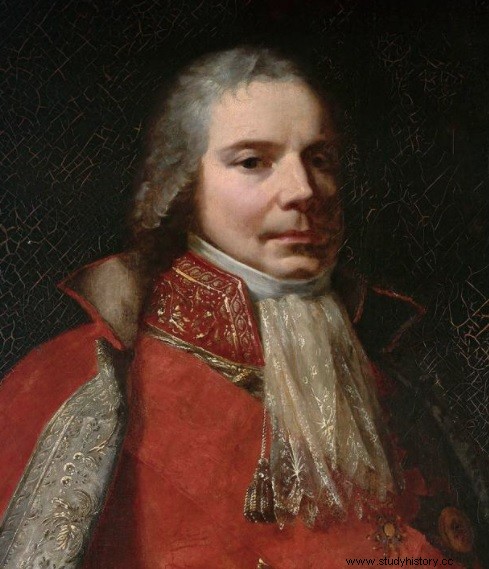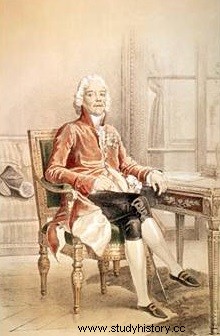 P singular character, Talleyrand (1754-1838) was a French diplomat and statesman of the Revolution and the Napoleonic period. Bishop of Autun, deputy to the States General and to the Constituent Assembly (1789), he was then Minister of External Relations of the Directory, then of the Consulate and of the Empire (1797-1807); it notably inspired the Treaty of Lunéville, the Concordat, the Peace of Amiens and the Treaty of Presbourg. Grand Chamberlain of the Empire and Prince of Bénévent, he left Foreign Affairs because he was opposed to the break with Austria. Vice-Grand Elector, he was disgraced in 1809. Head of the provisional government on April 1, 1814, he was Minister of Foreign Affairs under the First Restoration and played an essential role in the Congress of Vienna (1814-15).
P singular character, Talleyrand (1754-1838) was a French diplomat and statesman of the Revolution and the Napoleonic period. Bishop of Autun, deputy to the States General and to the Constituent Assembly (1789), he was then Minister of External Relations of the Directory, then of the Consulate and of the Empire (1797-1807); it notably inspired the Treaty of Lunéville, the Concordat, the Peace of Amiens and the Treaty of Presbourg. Grand Chamberlain of the Empire and Prince of Bénévent, he left Foreign Affairs because he was opposed to the break with Austria. Vice-Grand Elector, he was disgraced in 1809. Head of the provisional government on April 1, 1814, he was Minister of Foreign Affairs under the First Restoration and played an essential role in the Congress of Vienna (1814-15).
Childhood and first steps in politics of Talleyrand
Charles Maurice de Talleyrand-Périgord was born on February 2, 1754 in Paris. The son of a superior officer, the child, placed in foster care from his first days, was the victim, when he was only a few months old, of an accident which crippled him, leaving him with a club foot. From then on, Charles Maurice was no longer considered by his parents as the eldest in the family but as a younger brother, destined for the ecclesiastical state.
On April 1, 1775, despite his regular attendance at gambling dens and places of pleasure, his mistresses, his taste for reading travelogues, philosophers, the history of revolutions, Charles Maurice de Talleyrand-Périgord pronounced his vows in the church of Saint-Nicolas-du-Chardonnet. Thanks to his high birth, the young man was endowed by Louis XVI, on September 24, 1775, with the rich abbey of Saint-Remi de Reims. Ordained priest in December 1779, agent general of the clergy of France, he neglected the affairs of the Church. Money, women and gambling are his main interests. Freemason, the affiliation is fashionable, Talleyrand frequents the Parisian salons and, particularly, that of the Comtesse de Flahaut. Their liaison will last from 1783 to 1792, the Revolution separate them. A child was born from his affair with the Countess, Charles de Flahaut.
Charles Maurice is increasingly interested in politics. He wants to become a bishop, it turns out to be difficult. Finally, in 1788, his father obtained for him from Louis XVI the seat of Autun. His diocese does not interest him much, but it gives him the possibility of running for a seat in the States General. On April 2, 1789, the new prelate was triumphantly elected deputy of the clergy to the States General.
Acquired for a long time in new ideas, Talleyrand binds with Mirabeau; he will remain his friend until the death of the tribune. In October 1789, to the indignation of the other prelates, he advocated making the property of the clergy available to the nation, to make up for the financial deficit. For the first time, but not the last, Talleyrand is considered a traitor. In the Assembly, where he sits on the left, the Bishop of Autun is therefore a listened speaker, but does not appear as the leader of one of the fractions of the Constituent Assembly.
The Bishop of Autun, who was one of the few prelates to have accepted the Civil Constitution of the Clergy on December 28, 1790, resigned from his episcopal see in January. -pal. This did not prevent him from consecrating three constitutional bishops on February 24, then that of Paris a month later. Condemned shortly after by the pope, he broke with the Church.
A career as a diplomat
Under the Legislative, Talleyrand approaches diplomacy. Suspected, after August 10, 1792, of having relations with the king, he decided to settle in England. The diplomat went to the United States, where he remained from 1794 to 1796, when he returned to France. Barras' protection enabled him to be struck off the list of emigrants. Appointed Minister of External Relations in July 1797, Talleyrand became one of the prominent figures in the capital. Abandoning his portfolio, and the Directory, in July 1799, he moved closer to Bonaparte, supporting the young general in the preparation and execution of Brumaire's coup.
 This born courtier, with affable manners and obvious diplomatic qualities, seduced Bonaparte who forgot the various embezzlements of which he was charged. Also, in November 1799, Talleyrand returned to his post in External Relations. Inside, the minister advocates appeasement with the Catholics and the royalists; abroad, he sought a way to establish a lasting peace and negotiated in Lunéville in 1801, then in Amiens in 1802.
This born courtier, with affable manners and obvious diplomatic qualities, seduced Bonaparte who forgot the various embezzlements of which he was charged. Also, in November 1799, Talleyrand returned to his post in External Relations. Inside, the minister advocates appeasement with the Catholics and the royalists; abroad, he sought a way to establish a lasting peace and negotiated in Lunéville in 1801, then in Amiens in 1802.
Grand Chamberlain in 1804, Prince of Bénévent in 1806, he negotiated the treaties of Presbourg and Tilsit, but gradually broke away from the Emperor:not very favorable to war and in the policy of conquest, he showed himself to be rather in favor of a European balance, advocating an alliance with Austria, then with England. Shortly after the signing of the Treaty of Tilsit in 1807, Talleyrand gave up his portfolio. Some time later, the Emperor appointed him Vice-Grand Elector. Remaining alongside Napoleon as an adviser, the Prince of Bénévent disapproved of the Spanish expedition. Returning to Paris, he became closer to Fouché, who had fallen into disgrace, and plotted with him against the Emperor. Furious, the latter in turn disgraced him in January 1809, depriving him of his office as Grand Chamberlain.
Talleyrand, craftsman of the Restoration
In 1814, when the fate of arms turned against Napoleon, Talleyrand negotiated as much as he could with the allied sovereigns. Bringing together some sixty senators, he had them appoint a provisional government, of which he was of course the head. On April 2, the former Grand Chamberlain had the Senate proclaim the forfeiture of Napoleon and his family. While the Emperor gathered his marshals for the last time at Fontainebleau, his former minister was actively preparing for the return of the Bourbons. Louis XVIII could do no less than return the portfolio of Foreign Affairs to him on May 13. In September, he left to represent France at the Congress of Vienna, armed with instructions from Louis XVIII that he had drawn up himself. In Vienna, he manages to break up the alliance of the former enemies of France. A few months later, the adventure of the Hundred Days put an end to this skilfully executed work. The allies form a new coalition against France.
Appointed President of the Council during the Second Restoration, Talleyrand fairly quickly distanced himself from the king, who did not like him, while the ultras and, outside, the Tsar hates him. He resigned in September, endowed with the title of Grand Chamberlain. In the years that followed, the activity of the man with the six faces of cartoonists was limited to the Chamber of Peers. Passed to the opposition, he defends the freedom of the press, condemns the Spanish expedition of 1823, binds with Thiers and Royer Collard.
Having been in touch with the Duke of Orléans for a long time, he favored his arrival on the throne in 1830. In September, Louis-Philippe appointed him ambassador to London, post of primary importance. There, for five years, Talleyrand worked on Franco-English rapprochement. In November 1834, the old diplomat asked for his recall. From then on, he no longer participated in public affairs and died in Paris on May 17, 1838. Nicknamed the "lame Devil" because of his many reversals, Talleyrand has given rise to numerous biographies, plays and even films (Dinner , 1992), and wrote memoirs that are a true model of the genre. In the tradition of a Richelieu, he remains one of the most complex and enigmatic statesmen in the history of France.
Bibliography
- Talleyrand, the motionless prince, by Emmanuel de Waresquiel. Text, 2019.
- Talleyrand, biography of Georges Bordonove. Pygmalion, 2007.
- Memoirs and correspondence, by Charles-Maurice de Talleyrand. Robert laffont, 2007.
